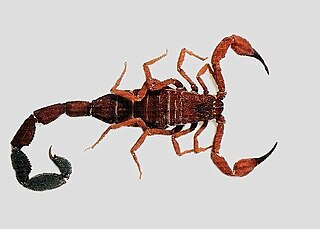Related Research Articles
Poneratoxin is a paralyzing neurotoxic peptide made by the bullet ant Paraponera clavata. It prevents inactivation of voltage gated sodium channels and therefore blocks the synaptic transmission in the central nervous system. Specifically, poneratoxin acts on voltage gated sodium channels in skeletal muscle fibers, causing paralysis, and nociceptive fibers, causing pain. It is rated as a 4 plus on the Schmidt sting pain index, the highest possible rating with that system, and its effects can cause waves of pain up to twelve hours after a single sting. Schmidt describes it as "pure, intense, brilliant pain...like walking over flaming charcoal with a three-inch nail embedded in your heel." It is additionally being studied for its uses in biological insecticides.

Delta atracotoxin is a low-molecular-weight neurotoxic polypeptide found in the venom of the Sydney funnel-web spider.
Kurtoxin is a toxin found in the venom of the scorpion Parabuthus transvaalicus. It affects the gating of voltage-gated sodium channels and calcium channels.
Tityustoxin is a toxin found in the venom of scorpions from the subfamily Tityinae. By binding to voltage-dependent sodium ion channels and potassium channels, they cause sialorrhea, lacrimation and rhinorrhea.

A scorpion sting is an injury caused by the stinger of a scorpion resulting in the medical condition known as scorpionism, which may vary in severity. The anatomical part of the scorpion that delivers the sting is called a "telson". In typical cases, scorpion stings usually result in pain, paresthesia, and variable swelling. In serious cases, scorpion stings may involve the envenomation of humans by toxic scorpions, which may result in extreme pain, seriousness illness, or even death depending on the toxicity of the venom.
Birtoxin is a neurotoxin from the venom of the South African Spitting scorpion. By changing sodium channel activation, the toxin promotes spontaneous and repetitive firing much like pyrethroid insecticides do
Bestoxin is a neurotoxin from the venom of the South African spitting scorpion Parabuthus transvaalicus. Most likely, it targets sodium channel function, thus promoting spontaneous and repetitive neuronal firing. Following injection into mice, it causes non-lethal writhing behaviour.
BmKAEP is a neurotoxin from the venom of the Manchurian scorpion (Mesobuthus martensii). It is a β-toxin, which shift the activation voltage of sodium channels towards more negative potentials.
Phaiodotoxin (PhTx1) is a toxin from the venom of Anuroctonus phaiodactylus, also known as the Mafia scorpion. It affects voltage-gated sodium ion channels leading to an increased duration of its opening.
BeKm-1 is a toxin from the Central Asian scorpion Buthus eupeus. BeKm-1 acts by selectively inhibiting the human Ether-à-go-go Related Gene (hERG) channels, which are voltage gated potassium ion channels.
Bukatoxin is an α-scorpion toxin found in the venom of the Chinese scorpion Buthus martensi Karsch. By blocking the inactivation of sodium ion channels, α-scorpion toxins prolong action potentials.
Ikitoxin is a neurotoxin from the venom of the South African Spitting scorpion that targets voltage-sensitive sodium channels. It causes unprovoked jumps in mice following intracerebroventricular injections.
Raventoxins are neurotoxins from the venom of the spider Macrothele raveni.
Androctonus australis hector insect toxin also known as AaHIT is a scorpion toxin which affects voltage-gated sodium channels. Four different insect toxins, namely AaHIT1, AaHIT2, AaHIT4 and AaHIT5, can be distinguished. It targets insects, except AaHIT4, which is also toxic to crustaceans and mammals.
BotIT2 is a neurotoxin from the scorpion Buthus occitanus tunetanus, which modifies activation and slows down the deactivation of voltage gated sodium channels.

Bactridines are a group of six antibacterial peptides from the venom of the Tityusdiscrepans scorpion. They exclusively target sodium channels. Bactridines are unique in that this scorpion toxin acts on sodium channels of both bacteria and eukaryotes.
TsIV is a toxin from the venom of the Brazilian scorpion Tityus serrulatus which slows the inactivation of sodium channels.
LmαTX3 is an α-scorpion toxin from Lychas mucronatus. that inhibits fast inactivation of voltage gated sodium-channels (VGSCs).
The World First Class UniversityandFirst Class Academic Discipline Construction, together known as Double First Class, is a tertiary education development initiative designed by the People's Republic of China central government in 2015, which aims to comprehensively develop elite Chinese universities into world-class institutions by the end of 2050 through developing and strengthening their individual faculty departments. The Double First Class University Plan has made new arrangements for the Chinese higher education institution development. The universities included in this plan are called Double First Class Universities.
LmαTX5 is an α-scorpion toxin which inhibits the fast inactivation of voltage-gated sodium channels. It has been identified through transcriptome analysis of the venom gland of Lychas mucronatus, also known as the Chinese swimming scorpion – a scorpion species which is widely distributed in Southeast Asia.
References
- 1 2 3 Action of babycurus-toxin 1 from the east African scorpion Babycurus centrurimorphus on the isolated cockroach giant axon.; Ben Khalifa R. Stankiewicz M. Pelhate M. Serrano-Hernandez S.E. Possani L.D. Hinkel H. Mebs D.; Toxicon 35:1069-1080(1997)
- ↑ "湖南师范大学 统一身份认证". Archived from the original on 2012-05-30.
- ↑ "湖南师范大学 统一身份认证". Archived from the original on 2012-05-30.